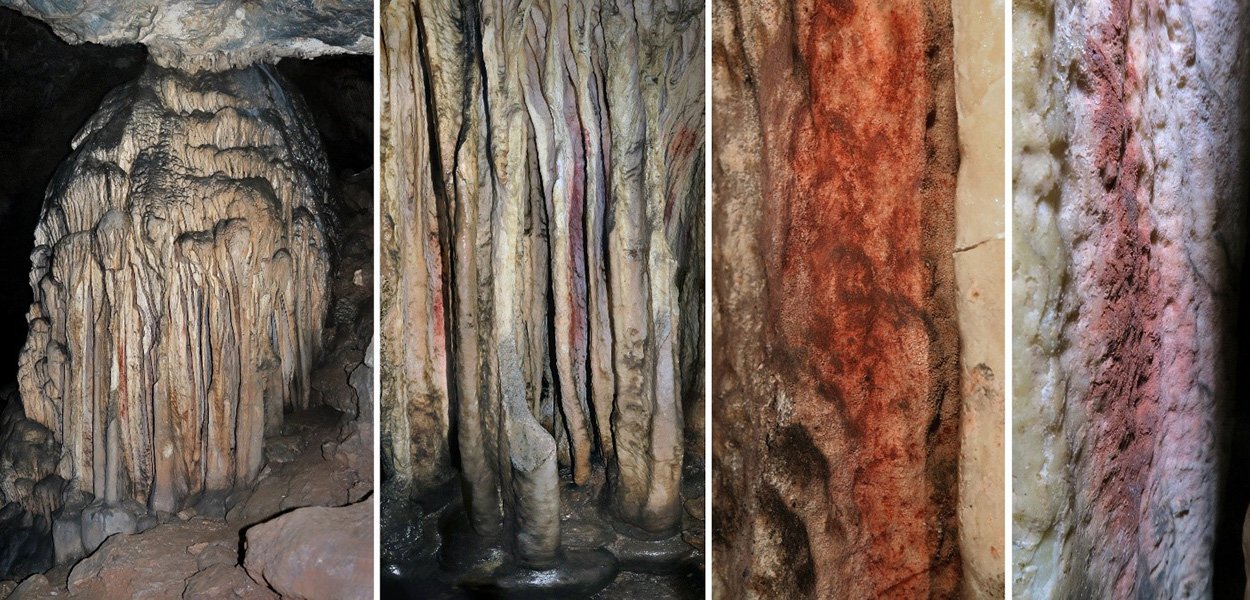At what point in human history did our ancestors become artists for the first time? A new analysis of red pigments in the Spanish cave Cueva de Ardales shows that these pigments were apparently applied deliberately – about 65,000 years ago. These marks were placed more than 20,000 years before the arrival of the first anatomically modern humans in Europe. Analysis indicates that Neanderthals used red to mark an important ritual site.
Cueva de Ardales in the Spanish province of Málaga is home to many rock paintings from different millennia. The 1,600-meter-long cave was discovered in 1821 after an earthquake exposed its entrance. The first rock paintings were recognized in 1918. Several pictorial images of various animals and symbols are known. Near the entrance to the cave, in the dome of a large stalagmite, there are also red pigments on the rocks, which were previously disputed whether they were deposited by natural processes or whether they were also human.
Paintings from the time of Neanderthals
A team led by Africa Petrarch Marti of the University of Barcelona, Spain, analyzed the composition of these pigments using different microscopic and spectroscopic methods and compared them to other minerals found in the cave. “Our results contradict the assumption that the coloration could be the result of natural processes,” the researchers report. The arrangement and composition of the pigments makes it clear that they cannot be caused by percolating water deposits or natural weathering of the walls. The researchers were also able to rule out microbial activities.
Some specimens have been dated to about 65,500 years ago. At that time there were no anatomically modern people in Europe. The colors on the rocks seem to come from Neanderthals who settled in the area in the Paleolithic. According to the analyzes, the main components of the red color are the iron-containing mineral hematite, aluminum silicate and calcite. They also found quartz and diamond-like carbon layers in some of the minute samples they took. A comparison with other specimens from the cave revealed: it is very likely that the color is not from the cave itself. Our results indicate that Paleolithic artists used iron-rich blocks collected in geological formations from a hitherto unknown source, which is likely to be found outside the cave,” the researchers said.
There is no art in the strict sense of the word
But were the dyes actually applied on purpose? In other cases, it has already been said that the discoloration on the rock walls could have arisen by chance when early humans wore dyed clothes or painted their bodies grazing in cramped spaces. Marty and her colleagues can rule this out: “The painted structures in the middle of a room are very large,” they explain. In addition, pigments are also found in deep crevices in the rock – even deeper than an arm can reach. According to the researchers, the paint was likely applied by blowing or spraying. This also fits the distribution pattern, where the coloration is stronger in the center and decreases towards the edges.
However, researchers do not classify paint applications as art in the narrow sense. This will require that the graphics have a symbolic value in themselves. “We believe that the cave itself is the symbol and that the paintings are there to identify it as such, not the other way around,” Marti and colleagues write. “So it is the result of a graphic behavior intended to perpetuate the symbolic meaning of the room.”
A symbolic place across generations
The dating of dyes indicates that they were applied at different times – initially about 65,500 years ago, and then again between 48,700 and 45,300 years ago. The composition of dyes from different times is also slightly different. “By combining the lines of evidence, history and composition, we can ensure that our samples represent at least two virulents, and we can also assume that their actual number is likely to be at least three or perhaps four,” the researchers say.
From this they concluded that many generations of Neanderthals visited and marked the cave repeatedly over thousands of years. Apparently they had a motive to return to the cave over and over and symbolically mark the place. “Our results support the hypothesis that Neanderthals used these large stalagmite plates and domes that symbolically house them over a long period of time.”
Source: Africa Pitarch Martí (University of Barcelona, Spain) et al., Proceeding of the National Academy of Sciences, doi: 10.1073/pnas.2021495118

“Alcohol buff. Troublemaker. Introvert. Student. Social media lover. Web ninja. Bacon fan. Reader.”







More Stories
Science: The use of artificial intelligence is changing the way hospitals operate
Simple recipe: sweet cream cheese slices from the tray
This is how our brain chooses what information it will remember in the long term